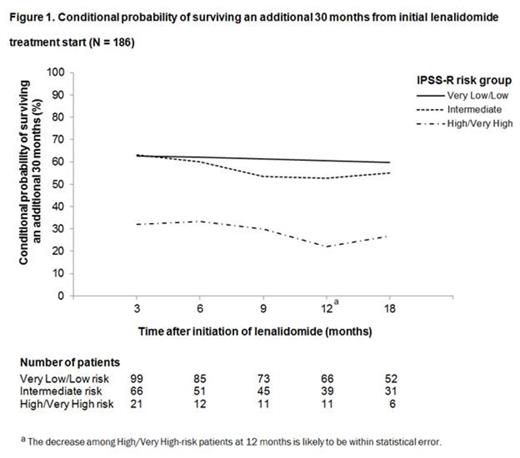Abstract

Introduction: Although trial results can be used to develop prognostic models for patient survival that are useful at the beginning of treatment, their accuracy as patients continue to receive therapy may decrease. With attention increasingly focused on defining treatment value and providing effective patient care, we evaluated how survival among patients with myelodysplastic syndromes (MDS) changes over time while on treatment. This analysis used conditional probability to address the practical question: what is the probability of a patient surviving y months after he/she has already survived x months since starting treatment with lenalidomide?
Methods: This analysis evaluated lenalidomide-treated patients with lower-risk MDS and del(5q) from the MDS-003 and MDS-004 studies (List A, et al. N Engl J Med. 2006;355:1456-65; Fenaux P, et al. Blood. 2011;118:3765-76). We calculated the probability of a patient surviving an additional 6, 9, 12, 18, 24, or 30 months on-treatment with lenalidomide after having received lenalidomide for an initial 3, 6, 9, 12, or 18 months. The conditional probability of surviving an additional y months was calculated as OS (x +y)/OS (x) within the Kaplan Meier survival framework.
Results: Of 286 lenalidomide-treated patients with MDS included in this analysis, 70% were women, median age was 69 years (range 36-95), and median time from diagnosis 2.7 years (range 0.1-29.2). Isolated del(5q) was present in 70% of patients and 73% were classified as having International Prognostic Scoring System (IPSS)-defined Low- or Intermediate-1-risk disease. The median transfusion burden for the population was 6 red blood cell (RBC) units/8 weeks (range 1-25). Within 3 months of starting treatment with lenalidomide, 139 of 286 patients became RBC transfusion-independent (defined as ≥ 8 consecutive weeks without RBC transfusions); 79, 123, and 139 patients were transfusion-independent by 1, 2, and 3 months, respectively. Of 286 patients, 242, 193, 165, 149, and 114 received lenalidomide for at least 3, 6, 9, 12, and 18 months, respectively. The conditional probability of lenalidomide-treated patients (regardless of response status) surviving an additional 6, 9, 12, 18, 24, or 30 months after receiving lenalidomide for the above treatment periods is presented in Table 1. The conditional probability values of a patient surviving an additional 6, 9, 12, 18, 24, or 30 months were similar regardless of initial lenalidomide treatment period. The conditional probability of surviving an additional 30 months after specific periods of lenalidomide treatment for patients stratified by Revised-IPSS (IPSS-R) group is shown in Figure 1. For patients in the IPSS-R Very Low/Low-risk and Intermediate-risk groups, the conditional probabilities of surviving an additional 30 months after 18 months of lenalidomide treatment were 59.8% and 55.2%, respectively. As expected, the conditional survival was lower in the High/Very High-risk group; even in these higher-risk patients, however, conditional probability of surviving an additional 30 months after 18 months of lenalidomide treatment was 26.7%.
Conclusions: Irrespective of initial treatment duration, the conditional probability of survival of MDS patients on lenalidomide remains remarkably consistent while on treatment for up to 18 months. Patients with lower-risk del(5q) MDS who had received up to 18 months of lenalidomide still had a > 55% conditional probability of surviving an additional 30 months on treatment. The ability to adjust survival estimates on the basis of time elapsed since starting therapy is clinically meaningful in counseling patients with lower-risk del(5q) MDS, and may be informative when planning healthcare resource use.
Conditional probability of survival after initial lenalidomide treatment period
| Time since initiation of lenalidomide, months . | n . | Conditional probability of additional survival, % . | |||||
|---|---|---|---|---|---|---|---|
| 6 months . | 9 months . | 12 months . | 18 months . | 24 months . | 30 months . | ||
| 3 | 242 | 93.7 | 88.9 | 83.6 | 75.4 | 67.4 | 60.9 |
| 6 | 193 | 92.3 | 86.8 | 81.8 | 74.7 | 66.0 | 59.7 |
| 9 | 165 | 89.3 | 84.0 | 80.4 | 71.9 | 65.0 | 57.6 |
| 12 | 149 | 88.6 | 84.8 | 81.0 | 71.5 | 64.7 | 56.9 |
| 18 | 114 | 91.4 | 85.6 | 80.7 | 73.0 | 64.2 | 56.0 |
| Time since initiation of lenalidomide, months . | n . | Conditional probability of additional survival, % . | |||||
|---|---|---|---|---|---|---|---|
| 6 months . | 9 months . | 12 months . | 18 months . | 24 months . | 30 months . | ||
| 3 | 242 | 93.7 | 88.9 | 83.6 | 75.4 | 67.4 | 60.9 |
| 6 | 193 | 92.3 | 86.8 | 81.8 | 74.7 | 66.0 | 59.7 |
| 9 | 165 | 89.3 | 84.0 | 80.4 | 71.9 | 65.0 | 57.6 |
| 12 | 149 | 88.6 | 84.8 | 81.0 | 71.5 | 64.7 | 56.9 |
| 18 | 114 | 91.4 | 85.6 | 80.7 | 73.0 | 64.2 | 56.0 |
List:Celgene Corporation: Honoraria, Research Funding. Giagounidis:Celgene Corporation: Honoraria. Hellström-Lindberg:Celgene Corporation: Research Funding. Shiansong Li:Celgene Corporation: Employment, Equity Ownership. Swern:Celgene Corporation: Employment, Equity Ownership. Sugrue:Celgene Corporation: Employment, Equity Ownership. Fenaux:Janssen: Honoraria, Research Funding; Amgen: Honoraria, Research Funding; Celgene Corporation: Honoraria, Research Funding; Novartis: Honoraria, Research Funding. Sekeres:Celgene Corporation: Membership on an entity's Board of Directors or advisory committees.
Author notes
Asterisk with author names denotes non-ASH members.

This icon denotes a clinically relevant abstract


This feature is available to Subscribers Only
Sign In or Create an Account Close Modal